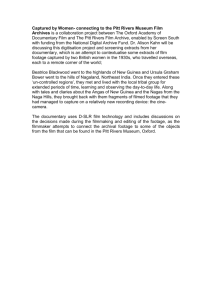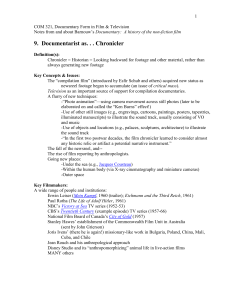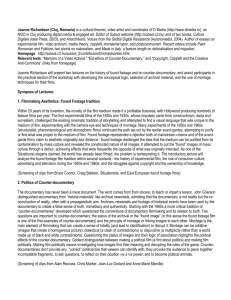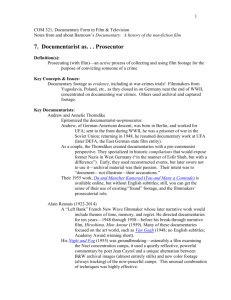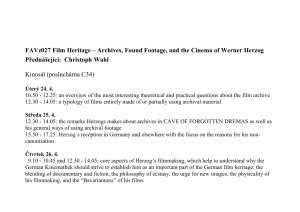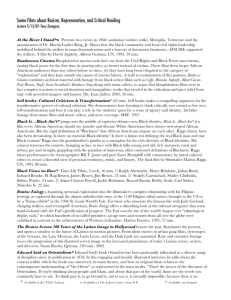Chronicler
advertisement
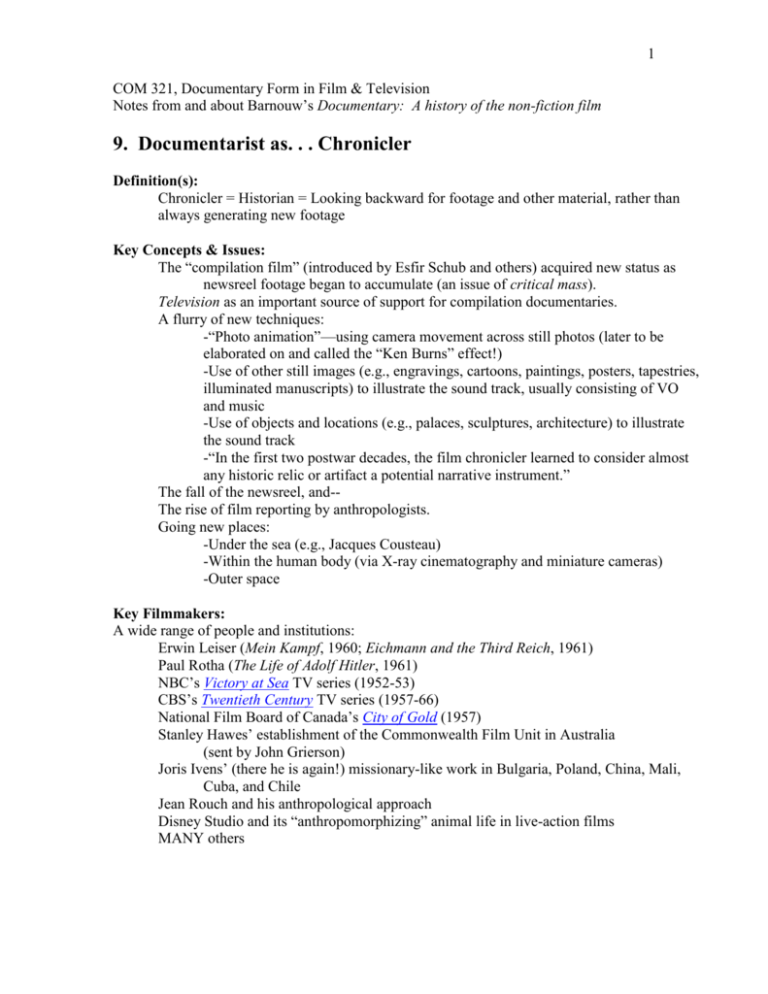
1 COM 321, Documentary Form in Film & Television Notes from and about Barnouw’s Documentary: A history of the non-fiction film 9. Documentarist as. . . Chronicler Definition(s): Chronicler = Historian = Looking backward for footage and other material, rather than always generating new footage Key Concepts & Issues: The “compilation film” (introduced by Esfir Schub and others) acquired new status as newsreel footage began to accumulate (an issue of critical mass). Television as an important source of support for compilation documentaries. A flurry of new techniques: -“Photo animation”—using camera movement across still photos (later to be elaborated on and called the “Ken Burns” effect!) -Use of other still images (e.g., engravings, cartoons, paintings, posters, tapestries, illuminated manuscripts) to illustrate the sound track, usually consisting of VO and music -Use of objects and locations (e.g., palaces, sculptures, architecture) to illustrate the sound track -“In the first two postwar decades, the film chronicler learned to consider almost any historic relic or artifact a potential narrative instrument.” The fall of the newsreel, and-The rise of film reporting by anthropologists. Going new places: -Under the sea (e.g., Jacques Cousteau) -Within the human body (via X-ray cinematography and miniature cameras) -Outer space Key Filmmakers: A wide range of people and institutions: Erwin Leiser (Mein Kampf, 1960; Eichmann and the Third Reich, 1961) Paul Rotha (The Life of Adolf Hitler, 1961) NBC’s Victory at Sea TV series (1952-53) CBS’s Twentieth Century TV series (1957-66) National Film Board of Canada’s City of Gold (1957) Stanley Hawes’ establishment of the Commonwealth Film Unit in Australia (sent by John Grierson) Joris Ivens’ (there he is again!) missionary-like work in Bulgaria, Poland, China, Mali, Cuba, and Chile Jean Rouch and his anthropological approach Disney Studio and its “anthropomorphizing” animal life in live-action films MANY others 2 [Other examples:] The Times of Harvey Milk (Rob Epstein, U.S., 1984)—according to your instructor, perhaps the most perfect “standard” documentary ever made. . . a compilation of existing or “found” images and footage from Harvey Milk’s private and public lives (including substantial local news footage), new interviews with key narrators who knew Milk (a real matrix of individuals who are gay or straight, male or female, insider or outsider-who-becameinsider; spokespersons who represent just about every viewpoint on Milk), and an intense omniscient VO by gay activist/playwright Harvey Fierstein. And of course a completely compelling story. A deserving award-winner! Henri Langlois: Phantom of the Cinematheque (Jacques Richard, France, 2005)—a very dense chronicler-type documentary that takes multiple viewings to absorb it all; a compilation of a wide array of sources, both old and new (e.g., interviews). These Amazing Shadows (Paul Mariano & Kurt Norton, U.S., 2011)—a chronicler-type documentary on the history and film preservation activities of the National Film Registry, a collection of American films deemed, by the Library of Congress, to be “culturally, historically or aesthetically significant.” Since 1989, 25 films a year have been archived. This documentary includes compelling clips from the films, interviews with members of the Registry’s Board and with prominent filmmakers and stars, and behind-the-scenes footage of the film preservation process. Nitrate Film Archivist George Willeman makes an unlikely featured player in the film; he can also be seen as a panelist in the 2011 CSU/CIFF Filmmaker Panel, “The Real Story—Documentary Filmmaking.” 2/14
